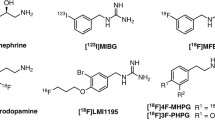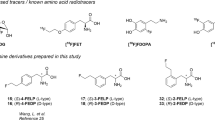Abstract
An analogue of meta-iodobenzylguanidine (MIBG) in which an aromatic hydrogen was replaced with fluorine has been found to possess many properties similar to those of the parent compound. Moreover, 4-fluoro-3-iodobenzylguanidine (FIBG) was retained in vitro by human neuroblastoma cells to a much greater extent than MIBG itself. Since alpha-emitters such as 211At could be valuable for the treatment of micrometastatic disease, an FIBG analogue in which the iodine atom is replaced by 211At would be of interest. In this study, we have evaluated the in vitro and in vivo properties of 3-[211At]astato-4-fluorobenzylguanidine ([211At]AFBG). The specific binding of [211At]AFBG to SK-N-SH human neuroblastoma cells remained fairly constant over 2- to 3-log activity range and was similar to that of [131I]MIBG. The uptake of [211At]AFBG by this cell line was reduced by desipramine, ouabain, 4 degrees C incubation, noradrenaline, unlabelled MIBG and FIBG, suggesting that its uptake is specifically mediated through an active uptake-1 mechanism. Over the 16 h period studied, the amount of [211At]AFBG retained was similar to that of [131I]FIBG, whereas the per cent of retained meta-[211At]astatobenzylguanidine ([211At]MABG) was considerably less than that of [131I]FIBG (53% vs 75%; P < 0.05). The IC50 values for the inhibition of uptake of [131I]MIBG, [211At]MABG, [125I]FIBG and [211At]AFBG by unlabelled MIBG were 209, 300, 407 and 661 nM respectively, suggesting that the affinities of these tracers for the noradrenaline transporter in SK-N-SH cells increase in that order. Compared with [211At]MABG, higher uptake of [211At]AFBG was seen in vivo in normal mouse target tissues such as heart and, to a certain extent, in adrenals. That the uptake of [211At]AFBG in these tissues was related to the uptake-1 mechanism was demonstrated by its reduction when mice were pretreated with desipramine. However, the stability of [211At]AFBG towards in vivo dehalogenation was less than that of [211At]MABG, as evidenced by the higher uptake of 211At in thyroid, spleen, lungs and stomach.
Similar content being viewed by others
Author information
Authors and Affiliations
Rights and permissions
About this article
Cite this article
Vaidyanathan, G., Zhao, XG., Larsen, R. et al. 3-[211At]astato-4-fluorobenzylguanidine: a potential therapeutic agent with prolonged retention by neuroblastoma cells. Br J Cancer 76, 226–233 (1997). https://doi.org/10.1038/bjc.1997.366
Issue Date:
DOI: https://doi.org/10.1038/bjc.1997.366
- Springer Nature Limited
This article is cited by
-
Human dosimetry of free 211At and meta-[211At]astatobenzylguanidine (211At-MABG) estimated using preclinical biodistribution from normal mice
EJNMMI Physics (2020)
-
Recent advances in radiotracers targeting norepinephrine transporter: structural development and radiolabeling improvements
Journal of Neural Transmission (2020)




